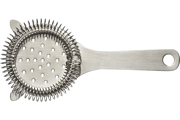Chimay Blue
Dark and very complex ale. Nutty, fruity and smooth.
$14, at
Total Wine
Orval
Bready, bitter and sweet with hints of floral and fruit.
$7, at Merwin
Rochefort 10
Our favorite—carmel, raisin, yeasty and velvety smooth.
$7, at
Belgian Shop
Westmalle Tripel
Wheaty and floral, with hints of honey and cream.
$5, at Beerboxx
Westvle-
teren 8°
Dark and earthy, this has a carmel and chocolate finish.
$20, at Beerboxx
La Trappe Dubbel
Mildly bitter and bready with notes of brown sugar and pear.
$6, at
Belgian Shop
Dubbel Monks
Checking the copper brew kettles at the Abbey of Rochefort in Belgium.
The Trappist monks, a group of monks originating from the Cistercian Order, have been brewing beer since the 16th century. Originally intended for self-consumption, they eventually shared their artisanal nectar with the outside world and it's now regarded by many as some of the finest beer known to man. But what makes it so good?
First is the tradition. The monks have been painstakingly brewing their beer for hundreds of years. After the French Revolution and two World Wars, there are only eight active Trappist breweries left in the world (six in Belgium, one in the Netherlands and one in Austria). With this resiliency and their strict regulations and quality control, you can rest assured that they've got the brewing process down pat.
The second reason is their commitment to authenticity. True Trappist beer must be made within the walls of a Trappist monastery, or if deemed necessary, in close proximity. The water for making the beer is usually drawn from the monastery's ancient wells. The brewing is either done by the monks themselves or under their direct supervision. Since the beer is not intended for making profit, the production is not influenced by demand. The proceeds cover the living costs of the monks, the brewery's expenses and the rest goes to charity. This results in limited quantities of batches per year, so if you like a particular year, you'd better stock up and put them in your basement. Luckily, since Trappist beer is fermented, it ages incredibly well for up to five years.
So if you're sick of over-hopped IPAs and gimmicky concepts, reach for a tried-and-true Trappist brew. Typically higher in alcohol content than your average beer, you get a smooth warming sensation that spreads with each sip. Which is exactly what you want you want on a cold day, right?
- The beers are classified by the names "enkel/single," "dubbel/double" or "tripel/triple." Since there was no way of measuring alcohol strength in the early days, monks would simply double or triple the recipe in order to make a stronger brew.
Comment
© Copyright 2024 Degitao Technology Pvt. Ltd - All Rights Reserved. | Privacy Policy | Terms & Conditions




